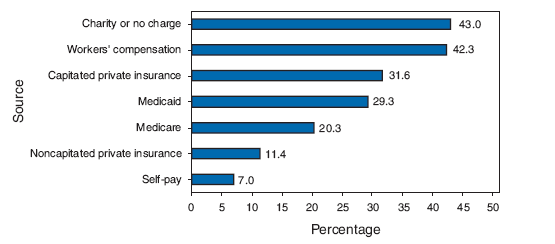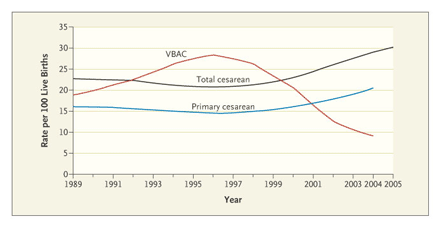New Study on Malpractice Costs
- Categories: Medical Malpractice, Data
- Printer Friendly|#| Trackback
Pacific Research Institute:
JACKPOT JUSTICE: The True Cost of America's Tort System
Processing....
Pacific Research Institute:
JACKPOT JUSTICE: The True Cost of America's Tort System
Processing....
Percentage of Office-Based Primary-Care Physicians Who Did Not Accept New Patients, by Expected Payment Source --- National Ambulatory Medical Care Survey, United States, 2003--2004

Recommendations of the Advisory Committee on Immunization Practices (ACIP)
I love barbecued ribs. I never tried to make them at home because I thought it must be too time intensive. Barbecued ribs have to be made on a barbecue, right? Wrong. Barbecued ribs can be made in a crock pot. I think these ribs are as good if not better than any you'll find in a restaurant (even a Texas barbecue restaurant). I'm posting it here because I've promised several nurses I'd bring in the recipe, always forget, so now I can just point them here.
Ingredients:
1. Remove inner skin from ribs (I use pliers to make this easier). Mix brown sugar, pepper, liquid smoke, garlic, and salt. Rub mixture onto ribs and cut them into 4 inch pieces. Layer ribs and onion in crock pot.
2. Cover and cook on low setting for 6-9 hours (depending on how your crock pot interprets 'low').
3. Remove ribs from pot. Drain and discard liquid.
4. Dip ribs into barbecue sauce, place ribs back into crock pot and pour any remaining sauce over ribs. Cook on low for an additional hour.
This recipe makes enough for 2-4 adults, depending on their appetite. For our family of 4, I make a double recipe (7 lbs of ribs) so there are sure to leftovers. I have tried this recipe with spare ribs instead of baby-back ribs and found it much too greasy for my liking.
I have cable modem service to my home via Comcast. I bought my own modem, the Motorola 4100, about three years ago so I wouldn't have to pay the cable modem rental fees. Since the modem only cost about $50, I've saved about one hundred dollars over that time period.
I had Comcast come install two CableCards in my new Tivo Series 3 and the installers commented on what an old modem I had. They went on to explain that one advantage of renting a modem is that, when the modem limits download speed, Comcast will replace it with a faster one. Having just installed a new Airport Extreme Pre-N wireless router, this seemed like something to check out.
After reading the spec. sheets on both modems it looks to me like their download speed is the same (38 Mbps). However, the Motorola 5101 I just installed is faster in my tests. Maybe it's the DOCSIS 2.0 support. Well, I'm just an unfrozen caveman anesthesiologist but I know speed when I see it...16 Mbps:

If you bought your own modem several years ago, consider upgrading it. The results might surprise you.
Download of the Day: Gmail Manager (Firefox) - Lifehacker
A must-have for a Firefox Gmail user
well, in Germany anyway...

As an anesthesiologist I provide anesthesia for cesarean sections quite often. In fact, when I'm on overnight call it's what I spend most of my time doing. Usually, anesthesia for c-section consists of a spinal anesthetic, or using a pre-existing epidural catheter, or (more rarely and usually only in emergencies) a general anesthetic. I am therefore quite interested in the subject of cesarean section rates and what effects how often they are done. I learned some things from this article [free full text]:
Cesarean Delivery and The Risk-Benefit Calculus
1. Parturients are different--they are heavier and older.
2. The number of premature and low birth-weight babies has grown.
3. Vaginal breech deliveries are no longer recommended.
4. Operative deliveries (forceps or vacuum) are less common due to better data describing their risks.
5. More labors are induced (20% in 2003 vs 9.5% in 1990) and induced labors are more likely to result in C-section.
6. Changes in provider behavior
Look at John Edwards' list of law cases (thank you, Google). Notice the medical malpractice cases:
|
MEDICAL MALPRACTICE CASES Another specialty Edwards developed was in medical malpractice cases involving problems during births of babies. According to the New York Times, after Edwards won a $6.5M verdict for a baby born with cerbral-palsy, he filed at least 20 similar lawsuits against doctors and hospitals in deliveries gone wrong, winning verdicts and settlements of more than $60M. |
||||
| Case | Summary of Facts | Case Type | Result | |
| Griffin v. Teague, et al. (Mecklenburg Co. Superior Ct., NC, 1997) |
Application of abdominal pressure and delay in performing c-section caused brain damage to infant and resulted in child having cerebral palsy and spastic quadriplegia. Verdict set record for malpractice award. | Medical Malpractice | $23.25M verdict |
|
|
Campbell v. Pitt County Memorial Hosp. (Pitt County, NC, 1985) |
Infant born with cerebral palsy after breech birth via vaginal delivery, rather than cesarean. Established North Carolina precedent of physician and hospital liability for failing to determine if patient understood risks of particular procedure. | Medical Malpractice |
$5.75M settlement |
|
| Wiggs v. Glover, et al. | Plaintiff alleged infant's severe cerebral palsy was caused by negligent administration of pitocin, failure to use fetal monitor, or timely intervening in baby's fetal distress. | Medical Malpractice |
2.5M settlement |
|
| Cooper v. Craven Regional Med. Ctr., et al. | Infant suffered severe brain damage after obstetrician failed to moderate use of Picotin after baby displayed clear fetal distress. | Medical Malpractice |
$2.5M settlement |
|
| Dixon v. Pitt County Memorial Hospital (Pitt County, NC) |
Birth-related injuries including cerebral palsy and mental retardation allegedly caused by obstetrician's failure to diagnose fetal distress, including umbilical cord wrapped around baby's neck prior to delivery. | Medical Malpractice |
2.4M settlement |
|
Despite the increase in c-section rates nationwide, we have seen no reduction in the cerebral palsy rate...
The abstract is here.
[AHRQ]
The Tesla Motors Blog, this entry by marketing chief Darryl Siry, sums up their business plan:
Excellent Lee Fleisher article in American Family Physician [free full text] for any primary care physician who is asked to do pre-op medical evaluations (note I didn't use the word 'clearance').
It's official (pdf). The Center for Medicare and Medicaid plans on cutting the physician fee schedule 9.9 percent as of January 2008. Five percent for 2007 (which cut was postponed due to a temporary one year patch), and 4.9% for 2008.
Prevalence of HPV Infection Among Females in the United States [free full text]
Remember, prevalence is the proportion of cases that are present at a single point in time.
For a background primer on HPV infection, see the excellent JAMA Patient Page.
In An Eye For An Eye, Charity Doc describes a close encounter with a malpractice attorney who once sued him. I'm not sure I would have been as, um, gracious....
OpinionJournal - Featured Article
More YouTube instructional video goodness. This time demonstrating a special syringe to aid in identification of the epidural space--the Episure AutoDetect Syringe.
Looks like a very nice training tool.
I personally use the Australian Grip. I learned it from an Australian anesthesiologist (hence my naming of it). I place the Tuohy needle in the interspinous ligament and attach a saline-filed glass syringe. I then apply pressure with the palm of my dominant hand to the plunger only, not touching the hub or needle. On entry of the epidural space, pressure on the plunger causes saline to shoot out of the Tuohy needle opening and the needle stops. The one wet tap I've had with this technique has been in a patient who must have had a non-union of the ligamentum flavum.
[Indigo-Orb]
The AHRQ published Making Health Care Safer: A Critical Analysis of Patient Safety Practices in 2001. Chapter 21 deals with Ultrasound Guidance of Central Vein Catheterization. I thought I'd include a link to a YouTube video that shows how this device is used:
Although the device has advance considerably since then (see below), the images it provides are still pretty much the same.
I will often use the device to locate and mark an internal jugular vein before draping the patient as I find the use of the needle guide extremely cumbersome.
[Site-Rite]
![]()